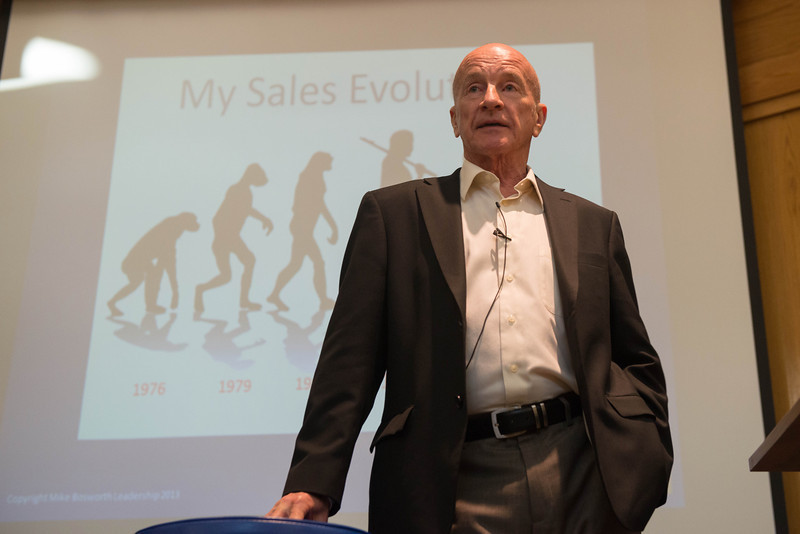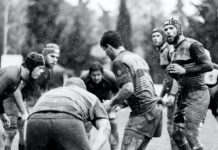Methodology and Philosophy (1990s – 2010’s)
- Relationship Selling – Develop strong trust-based relationships to encourage buyers to make a commitment (1990’s – Mike Bosworth)
- Solutions Selling – Work with customers to develop a mutual understanding of the solutions that would be a best fit (2000’s)
- Challenger Sale – Challenge customers to think differently while controlling the sales process (2011 – The Corporate Executive Board)
1990s to 2000s
Mike Bosworth began his career in 1972 with Xerox and from 1976 to 1982 was the primary architect and deliverer of Xerox sales training – PSS. In 1983, Bosworth founded his company Solution Selling – a sales training organisation. In 1993 he published Customer Centric Selling, proposing a solutions orientation to sales. Like Needs Satisfaction and SPIN, this version of solution selling proposed a number of distinct phases:
- Pre-call planning and research
- Stimulating interest
- Establishing the critical business issues
- Mapping the organisation
- Negotiating access to senior decision-makers
- Managing the product evolution
- Negotiating
- Closing

The flaw in this version of solution selling is that it’s not “solution selling” oriented. Phase 6 “Managing the product evolution” indicates that this system is still about the product, solution selling is not. What research has shown is that Solution Selling is about how customers view solutions, not how salespeople define them. In fact, all of the methods that support real Solution Selling encourage salespeople to work with their customers to gain an understanding of what the customer believes is an ideal fit solution.
As in the Blue Sheet approach used by Miller Heiman in Strategic Selling, solutions salespeople are expected to master a process for establishing strategic alignment between themselves and the buyer by going through the visioning process model described above.
Since the 1990s sales organisations have been bombarded with a host of methodologies; almost all of them shades of either PSS (Needs Satisfaction Selling) or SPIN (Consultative Selling).
2010s
Now we have many different sales specialists, consultants, psychologists and academics all working closely with salespeople and customers with the purpose of trying to identify what is really required in the world of selling.
No one individual that we could find can lay claim to being the parent (or founder) of Solution Selling. Equally important, not one authority can lay claim to having identified the perfect solution selling proposition. It’s been a process of synthesis and observation, trial and error but most importantly, it’s been the observation and the discussions with customers that has finally resulted in the realities of solution selling today.
Historically, customers needed salespeople. Initially they needed salespeople to inform them because they had little access to information. They also had limited choice. Over the last century, but more particularly, over the last decade or so, the same customers have been overwhelmed with information. They don’t need salespeople to provide information, they need salespeople to help them wade through the masses of available information to find the salient facts and identify the best fit solution.
Salespeople are no longer purveyors of the latest news about the latest gadgets, inventions and ideas. They certainly aren’t necessarily the first port of call for customers who are looking for a particular solution to a pressing challenge. They most definitely are not even a consideration for the purchase of commoditised items that require little technical knowledge or understanding.
In this paradigm the role of the sales professional has changed. Now, even more than when the concept was first developed in the 1970s, salespeople have to be consultative. They need to be business people who can sell, rather than salespeople who understand business. They need to have the skills to establish and fast track trusted relationships with a range of decision-makers in the variety of organisations with which they work.

One need only spend a week in the field, meeting with customers to know the game has changed. Sales strategies and tactics that worked well in the not too distant past, are no longer enough. Yes, salespeople should bring ideas to customers to help them grow their business and solve business problems. That’s nothing new. That was proposed as the underlying premise of PSS in 1968; by Miller Heiman (Strategic Selling) in the late 1970s, by Neil Rackham (SPIN) in the 1980s; by Mike Bosworth in the 1990s (Customer Centric Selling) and even by Dale Carnegie (How to Win Friends and Influence People – 1938).
Perhaps the closest to a revolution in selling since the 1968-1970s metamorphosis was the evolution of Solution Selling around 2000 – a method that evolved as a result of customer demands and expectations that forced sales professionals to re-think their approach.
The over-load of information, access to massive choice of hardly differentiated products and services (even at a complex level), and the increase in influence that buyers had on sales, coupled with pressure to reduce costs and improve profits of the buying organisations, forced salespeople to open up, share control of the sales and partner with customers to identify real and meaningful solutions.
In this era, buyers were (and still are) willing to identify preferred vendors, supplies and service providers, but they expect them to be more flexible. They want their suppliers to invest in understanding their business imperatives and then develop solutions that deliver more profits at both lower cost and less risk. Customers, not salespeople, define a solution and sales learned quickly that it would either adapt to this new environment or perish.
Solution Selling is a sales method that has been, and continues to be, driven by customer demands.
In November 2011 Matt Dixon and Brent Adamson published The Challenger Sale: Taking Control of the Customer Conversation. This book rapidly became a bestseller based on the premise that sales success isn’t just about building relationships with customers, it is also about challenging them. Authors of the book, Dixon and Adamson, studied thousands of sales representatives, across an array of industries around the US. This conclusion validated what David Ogilvy (1911–1999), the advertising guru responsible for developing relationship marketing as a concept, said back in the early 1990s, that relationships opened the door and gave the salesperson an opportunity to pitch their argument. Relationships even allowed the salesperson and sales organisation to make a mistake or two. Because a relationship existed the salesperson was given a second chance. But “in and of itself” (Ogilvy quotations) relationships won’t generate business…”

The Challenger Sale also says that the model shouldn’t just be a sales process but rather a company-wide initiative that incorporates other functional areas including marketing, product development, manufacturing and strategy, which is what Peter Drucker referred to in his book The Age of Discontinuity (1953): Organisations keen on being customer focused needed to adapt their approach to helping their customers realise their goals and objectives. “The purpose of business is to satisfy the customer’s needs. The consequence of satisfying customer needs, is making a profit.”
According to the authors (of The Challenger Sale), to sell in a business-to-business context solutions salespeople must approach customers with unique insights that show them how they can save or make money, as it was stated by PSS, in the way of pushing salespeople to introduce benefits in the form of dollars that could be created or saved, and later Strategic Selling (Miller Heiman – 1995) which stressed the importance of selling dollars earned or saved.
The Challenger Sale also recommends that instead of a bludgeoning customers with endless facts and features about the company and products, salespeople should tailor their sales message to the customer’s specific needs and objectives. This reflects what the Fuller Brush company did in 1928 with its massive door-to-door sales force and powerful sales management led by Albert Teetsel. Teetsel told salespeople not to overwhelm housewives with too many facts about the different brushes they had to offer. “Quickly establish what the best brush would be for the housewife and then stick to the basic feature of making the house cleaning easier and quicker, giving the lady of the house time to enjoy listening to the radio. Facts and figures only confuse customers”, said Teesel.

This sales methodology also recommends that salespeople should be more assertive pushing back when necessary in taking control of the sale. This advice was shown to be flawed by Miller Heiman in Strategic Selling, Mike Bosworth in Customer Centric Selling and even Neil Rackham in SPIN, simply because customers do not like to be antagonised, and certainly resist being controlled.
That doesn’t mean that salespeople have to be wimps. Customers expect salespeople to have strong views. They want salespeople to understand the world in which they are operating, and to have sufficient confidence in their own organisation and the solutions they are proposing, to put up some argument based on a valid business reason. But they don’t expect salespeople to try to manipulate them.
The Challenger Sale defines the attributes of successful salespeople. But, the logic is somewhat flawed. For example, by attempting to present salespeople who are good at relationship building as being too supportive and too generous with their time, as opposed to what they identify as the “ideal” – The Challenger – who loves to debate.
Challenger Salespeople do several things that, according to the authors, make them different and successful: they always have a different view of things, they love to debate, they love to control the sales call, they understand the customer’s business and they push their customers.
However:
• If a salesperson didn’t have a different point of view, what would be the reason for a prospect to meet with them? If all the salesperson has to offer is already known, then the buyer can more cost-effectively do their own research.
• If a salesperson is simply going to meet with customers to prove a point (debate) they are more likely to get thrown out of the meeting, unless the discussion is on equal terms with both buyer and seller sharing opinions with neither striving for one-upmanship.
• And if salespeople still believe they can control the sales call they are living in a fools-paradise. Customers are equal partners in the sale. They share the interaction and would never allow salespeople to control them – the risks are just too high.
• But if salespeople fail to push their customers, if they fail to come up with concepts, ideas and solutions that are radical, then they are offering pedestrian solutions, usually undifferentiated and hardly enough to excite discerning buyers.
What customers do strenuously resist today is dealing with salespeople who know it all; salespeople who attempt to take control or confront decision-making processes.
Customers, particularly in the Australian market and increasingly worldwide, are looking for a collaborative approach to buying and selling, where they can work with sales professionals who bring their in-depth knowledge and understanding of how solutions can be applied and who work with their customers who also have an in-depth knowledge of their own business and challenges. The two – buyer and seller – work collaboratively, in partnership, to develop solutions that deliver the greatest effectiveness and improved efficiency, with the least possible risk at a total cost of ownership that is bearable and justifiable.
The History of Sales Methodology – Part 1 (1900 -1950s)
The History of Sales Methodology – Part 2 (late 1950s – 1980s)
































